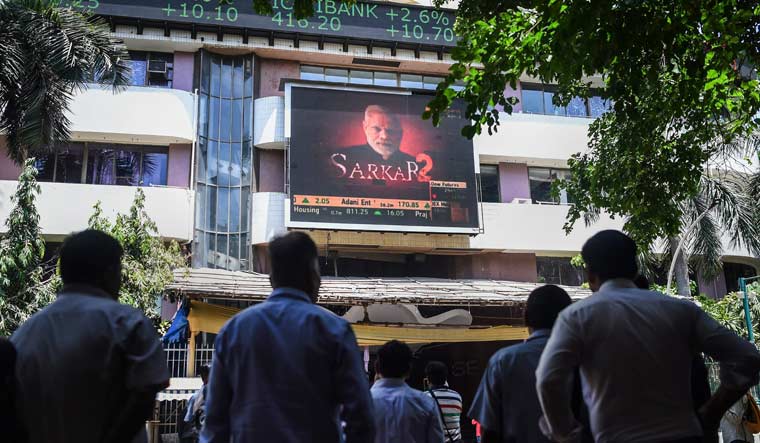The BSE Sensex zoomed more than 600 points on Friday, with investors hoping that post the decisive mandate that the Narendra Modi-led NDA secured in the parliamentary elections, the government will get going with a slew of reforms to revive a slowing economy.
The Sensex had topped 40,000 level for the first time on Thursday with Modi set to win the elections. However, the markets had ended lower on profit booking. Now that the election event risk is behind, the sluggish economy is back in the spotlight.
“The market will view the return of the Modi government positively; it will expect the government to announce further economic and governance reforms over the next few months,” said Sanjeev Prasad, co-head of Kotak Institutional Equities.
The Sensex closed 623 points or 1.6 per cent higher at 39,434.72 points and the NSE Nifty 50 index gained 187 points or 1.6 per cent to end the day at 11,844.10 points.
India’s industrial production contracted in March and the GDP growth has also slowed down over the last three quarters. Sonal Varma, chief India economist at Nomura Securities, does not expect a turnaround in the weak economic conditions in the short-term, but says the end of political uncertainty and the policy continuity will be a positive.
“The policy priority in the second term will be reigniting growth with prudence as a secondary priority. We expect a mix of rural reflationary policies (via fiscal support and productivity enhancement), infrastructure spending, tax simplification and social investment (housing for all). Reforms to the ease of doing business are also likely,” said Varma.
Banks, auto and select capital goods stocks were among the major gainers on Friday.
In the wake of the recent surge, market valuations have become expensive; the Nifty index trades at 18.1 times 2019-2020 earnings expectations, assuming a 24 per cent increase in net profits. The earnings growth will largely be driven by a recovery in banks earnings.
“A large portion of incremental earnings of the Nifty 50 Index comes from banks where we expect a strong recovery in profits on the back of lower loan-loss provisions. Thus, the growth in overall net profits of the market reflects normalization of profits in the banking sector and is not based on a swift recovery in India’s economy,” said Prasad.
Investment Bank Morgan Stanley, which is “overweight” on India in its emerging markets portfolio, sees Sensex touching 45,000 and Nifty at 13,500 by June 2020.
“We expect the RBI to be more accommodative and the economy to come out of its soft patch of the past few months. Earnings could be heading into a new cycle and domestic flows should return with strength,” said Ridham Desai, MD of Morgan Stanley India.
Another investment bank Goldman Sachs is also “overweight” on India and expects the benchmark indices to continue to outperform, relative to the rest of the region.
“We see potential reforms focusing on four key themes: (i) Land – transparent auctions, and digitization of records; (ii) Labor – creating an enabling regulatory environment; (iii) Privatisation – in areas such as agriculture and banking; and (iv) Export promotion – through targeting new export markets such as Eastern Europe and Central Asia; and creating a credible system of grading and certification,” said Prachi Mishra, chief India economist and Sunil Koul, Asia-Pacific Portfolio strategist at Goldman Sachs.
Goldman currently prefers stocks of banks and domestic cyclicals, over those of export oriented companies and defensive sectors (eg. pharma, FMCG).



